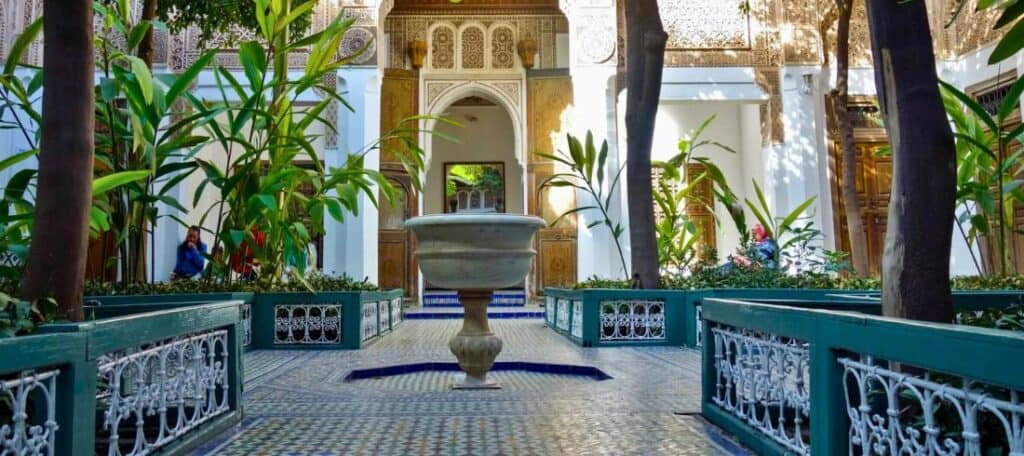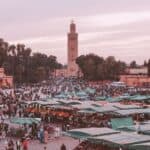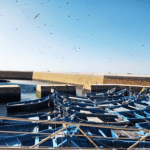
Imagine entering a world of enchantment, where every corner is adorned with intricate tilework, carved wood, and stucco plaster. Picture the sound of trickling fountains and the fragrance of blooming flowers filling the air. Welcome to Bahia Palace in Marrakech, Morocco.
Located in the heart of Marrakech, this architectural marvel is a testament to Moroccan artistry and a popular attraction for travelers from around the world. Built in the late 19th century, Bahia Palace was originally a residence for Si Moussa, a former slave who rose to prominence in the royal court. Over time, the palace was expanded by his son, Bou Ahmed, and transformed into a masterpiece of Moroccan design.
As you enter Bahia Palace, you’ll be captivated by its grandeur. From the intricately decorated courtyards to the luxurious reception halls and private quarters, every inch of the palace showcases the beauty and elegance of Moroccan architecture. The Alawi style, characterized by its Islamic and Moroccan influences, is evident in the colorful zellij decorations, carved-cedar ceilings, and tadlak finishes.
But Bahia Palace offers more than just architectural splendor. Step outside and discover the palace’s sprawling gardens, spanning over eight hectares. Lose yourself amidst the lush greenery, meandering through aromatic citrus groves, vibrant flower beds, and serene water features. The gardens provide a tranquil oasis in the bustling city of Marrakech, where you can relax and take in the breathtaking surroundings.
No trip to Marrakech is complete without a visit to Bahia Palace. Immerse yourself in the wonders of Moroccan design, explore its 160 rooms, indulge in the beauty of the gardens, and be transported to a world of timeless elegance.
- Bahia Palace is a must-see travel destination in Marrakech, Morocco.
- The palace showcases stunning Moroccan architecture and craftsmanship.
- It was originally built as a residence for Si Moussa, a former slave who became a prominent royal court member.
- Bahia Palace features intricate tilework, carved wood, and stucco plaster.
- The palace’s eight-hectare gardens provide a peaceful and picturesque setting.
History and Architecture of Bahia Palace :
The history of Bahia Palace can be traced back to the late 19th century when it was constructed by Si Moussa, a prominent figure in the Moroccan royal court. Si Moussa, who started as a slave and later became a vizier to the sultan, played significant roles in the political landscape and construction projects of the country.
The initial purpose of the palace was to serve as a residence for Si Moussa and his family. Over time, it underwent expansion under the leadership of his son, Bou Ahmed. The palace was named “Bahia” after Bou Ahmed’s favorite wife, known for her exceptional beauty and intelligence.
Bahia Palace is a testament to the blending of Islamic and Moroccan architectural styles. The palace showcases exquisite tilework, stucco carvings, and painted wooden ceilings, reflecting the incredible artistry of Moroccan craftsmen. The central courtyard of the palace stands out as a remarkable feature. Surrounded by rooms and galleries adorned with vibrant tilework and ornate furnishings, it epitomizes the grandeur of Moroccan architecture.
The upper floors of Bahia Palace house the private apartments of the sultan’s wives and concubines. These living spaces exude luxury, boasting intricate details and lavish designs.
Moorish Influence and Almohad Architecture :
The history and architecture of Bahia Palace are deeply rooted in the rich Moorish influence and Almohad architectural traditions. The Almohad dynasty, known for its immense contributions to Moroccan artistry, left an indelible mark on the palace’s construction and design.
Almohad architecture is characterized by features such as intricately carved stucco, zellij decorations, and geometric motifs. It embraces the fusion of art and functionality, resulting in visually stunning structures that embody the creativity and skill of Moroccan artisans.
Bahia Palace is a testimony to Morocco’s architectural heritage and the country’s dedication to preserving its cultural legacy. It serves as a captivating depiction of the opulence and artistry of the past, inviting visitors to delve into Morocco’s captivating history and architectural magnificence.
| Characteristic | Description |
|---|---|
| Intricate Tilework | The palace features beautifully adorned tiles, showcasing intricate patterns and vibrant colors. |
| Stucco Carvings | Elaborate stucco carvings can be found throughout the palace, showcasing the fine craftsmanship of Moroccan artisans. |
| Painted Wooden Ceilings | The ceilings of the palace are adorned with exquisite painted designs, adding an element of elegance and sophistication. |
| Central Courtyard | The palace’s central courtyard is a focal point, surrounded by striking architecture and lush greenery. |
Exploring Bahia Palace and its Gardens :
When visiting Bahia Palace, visitors can explore its many rooms and gardens and immerse themselves in its stunning beauty. The palace, covering an area of approximately 8 hectares, consists of interconnected courtyards, gardens, and buildings. It showcases an array of exquisite architectural features, including intricate zellij decorations, carved-cedar ceilings, talk finishes, and zouak-painted ceilings.
The palace’s reception halls and private quarters are lavishly adorned, providing a glimpse into the opulent lifestyle of its former residents. Every room is a testament to Moroccan artistry, with stucco panels, tiled floors, smooth arches, and shiny marble finishes adding to its grandeur.
One of the highlights of Bahia Palace is its breathtaking eight-hectare gardens. These well-manicured and beautifully landscaped gardens offer a tranquil escape from the bustling city. As visitors wander through the pathways, they can take in the sights and fragrances of the lush greenery, admiring the serene ambiance of the meticulously maintained grounds.
The gardens of Bahia Palace serve as a picturesque backdrop, further enhancing the overall experience and adding to the palace’s charm. This harmonious blend of architectural magnificence and natural beauty makes exploring Bahia Palace and its gardens an unforgettable journey into the heart of Moroccan heritage.
Conclusion :
In conclusion, the Bahia Palace in Marrakech is a must-see attraction for travelers interested in Moroccan architecture and history. This stunning palace showcases the country’s rich cultural heritage and offers visitors a glimpse into the opulent lifestyle of Morocco’s past.
From the intricate tilework and stucco carvings to the beautifully landscaped gardens, Bahia Palace is a visual feast for the senses. Exploring the palace’s 160 rooms and wandering through its eight-hectare gardens is a captivating experience that shouldn’t be missed.
Plan a visit to Bahia Palace on your next trip to Marrakech and immerse yourself in the wonders of Moroccan architecture and design. Whether you’re a history enthusiast or simply looking for a unique travel destination, the Bahia Palace will leave you in awe of its beauty and grandeur.
FAQ
What is Bahia Palace?
Bahia Palace is a mesmerizing architectural gem located in Marrakech, Morocco. It is a popular travel destination known for its stunning Moroccan design and craftsmanship.
When was Bahia Palace built?
Bahia Palace was built in the late 19th century.
Who built Bahia Palace?
Bahia Palace was originally constructed as a residence for Si Moussa, a former slave who became a prominent royal court member. His son, Bou Ahmed, later expanded it.
What architectural styles are showcased in Bahia Palace?
Bahia Palace showcases a blend of Islamic and Moroccan architectural styles, featuring intricate tilework, stucco carvings, and painted wooden ceilings.
What can visitors see and explore in Bahia Palace?
Visitors can explore the palace’s 160 rooms, including reception halls and private quarters. They can also admire the beautifully landscaped gardens and stunning courtyards.
What is the entrance fee for Bahia Palace?
The entrance fee for Bahia Palace is 70 Moroccan Dirhams (approximately USD) per person.








